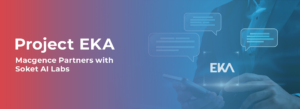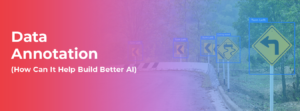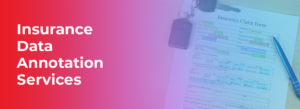Empower NLP text annotation with Human-AI collaboration
Artificial intelligence and its applications are here to stay. This technology has changed how we interact with the world and has gone from a science fiction dream to a critical part of our lives. Some of the most developed sub-fields of AI are machine learning, deep learning, neural networks, natural language processing, and computer vision. These sub-fields have different applications; most of the time, these sub-fields work in convergence. For example, many natural language processing models use machine learning to establish communication channels between humans and machines. In this blog, we will look into NLP, understanding of NLP text annotation, its types, and much more.
What is natural language processing?
Natural language processing (NLP) is one of the biggest sub-fields of artificial intelligence that enables computers to understand, manipulate, and interpret human language. NLP text annotation uses text and speech data to train models like chatbots, machine translation engines, voice bots, and sentiment analysis, improving productivity for many businesses like healthcare, banking, insurance, e-commerce, telecom, etc.
Many of the NLP text-based models are developed in convergence with supervised or semi-supervised machine learning, and to develop a natural language processing model based on this learning, we need a lot of annotated text corpora. An annotated text corpus means text data in huge quantities with proper annotation of every entity for given use cases. Labeling this type of data will take a lot of work, but luckily, Macgence has experienced annotators to deal with such a vast amount of unlabeled data. In the shortest turnaround time, Macgence will help the NLP text annotation developers get all the text data labeled so you can train their model for sentiment analysis.
What is text annotation in machine learning?
Text data annotation can assign labels or metadata to a document or parts of its content, like keywords, phrases, and sentences. The annotated text helps machines understand the context of human languages. Similar words used by people may have different intentions or sentiments, and NLP text annotation techniques help us to understand the true meaning of words or the context of any given sentence or text document.
Types of Text Annotation Techniques

Sentiment Annotation
Often, humans tend to be sarcastic in their responses. Especially on websites and reviews, we tend to share our bad experiences with a restaurant or a hotel through sarcasm, and machines could easily misinterpret them as compliments. If every sarcastic comment is learned as a compliment by machines, this would completely skew the results. That’s why sentiment annotation becomes crucial. This technique specifies the emotion or attitude behind a sentence (sarcasm); every sentence is labeled as neutral, positive, or negative.
Intent Annotation
This technique differentiates the intentions of users. When interacting with chatbots, different users respond with different intentions. Some request statements, others command responses for overcharges, a few confirm the debit of money and more. These distinct types of desires are classified through appropriate labels in this technique.
Entity Annotation
This is the most crucial NLP text annotation technique, which is used to identify, tag, and attribute multiple entities in a given text or sentence. We could break down entity annotation further into the following:
- Keyphrase tagging – this involves locating and identifying keywords in a text.
- Named Entity Recognition – this involves annotating proper names such as names of people, places, countries, and more.
- Parts Of Speech Annotation involves identifying nouns, verbs, adjectives, punctuations, prepositions, and more in a sentence.
Text Classification
Otherwise known as document classification or text categorization, NLP text annotators read chunks of paragraphs or sentences and understand the sentiments, emotions, and intentions behind them. They then classify the text based on their comprehension into categories specified by their projects. It could be as simple as classifying a piece of the article under entertainment or sports or as complex as categorizing products in an eCommerce store.
Linguistic Annotation
Linguistic annotation involves a bit of everything we discussed so far, but the only difference here is that the annotation process is done based on language data. Because of this, this technique involves an additional annotation type called phonetics annotation, where intonations, natural pauses, stress, and more are tagged.
Text Annotation Use Cases
Text annotation is used in various industries and sectors where natural language processing (NLP) and machine learning are used. Here are a few industries where NLP text annotation is commonly used:
Medical Research and Healthcare:
- Annotators may annotate text in the medical literature with terms related to illnesses, ailments, and treatments to create datasets for knowledge discovery and information extraction.
Finance:
- Financial institutions use NLP text annotation to analyze news stories, social media posts, and financial reports to measure market sentiment.
- Analysts annotate financial documents to extract pertinent information for risk assessment and decision-making.
Retail and E-commerce:
- E-commerce uses text annotation to extract product attributes, analyze customer sentiment from reviews, and categorize products.
- It aids in comprehending trends, product preferences, and customer feedback.
Customer service and support:
- Businesses classify and examine email correspondence, chat transcripts, and customer support tickets using NLP text annotation to speed up response times and spot recurring problems.
Legal and Compliance:
- Legal professionals use text annotation to categorize and extract data for legal research and compliance from contracts, case law, and legal documents.
How does Macgence’s HITL (Human-in-the-loop) approach help?

Key benefits of the HITL approach in NLP text annotation include:
Improved Accuracy and Quality
Macgence’s experts better understand ambiguous and complex data, allowing them to identify and correct errors that automated systems might overlook. This is particularly beneficial in scenarios involving rare data or languages with limited examples, where machine learning algorithms alone may struggle.
Enhanced Contextual Understanding
Humans bring nuanced judgment and contextual knowledge to NLP text annotation, which is crucial for tasks requiring subjective interpretations, such as sentiment analysis. Macgence’s human involvement ensures more precise and meaningful labeling of data.
Edge Case Resolution
HITL is valuable in addressing challenging edge cases that require human judgment and reasoning, which are often difficult to handle accurately. Macgence’s human annotators can ensure they correctly label these rare or complex instances, which enhances the reliability and performance of the AI models trained on this data.
Continuous Improvement:
The HITL approach facilitates an iterative feedback loop, where human annotators provide insights and feedback to improve automated systems. This collaboration leads to ongoing refinements in the accuracy and quality of annotations over time.
Active Learning and Querying
HITL systems can use active learning techniques, where the model queries humans for annotations on uncertain or challenging examples, thereby focusing human effort on the most informative instances. This optimizes the annotation process and improves annotation accuracy while reducing overall effort.
Quality Control
Human annotators adhere to specific quality control measures and guidelines, ensuring that annotations meet the desired standards with Macgence. Techniques like involving a third-party annotator for consensus or employing consensus-building strategies. Among multiple annotators enhance the reliability and reduce the impact of individual biases.
Macgence leverages the HITL approach in NLP text annotation and combines the strengths of human intelligence and AI capabilities. Resulting in more reliable, accurate, and contextually nuanced NLP models. This synergy is pivotal in advancing the effectiveness of AI-driven data annotation. Particularly in complex, ambiguous, or highly subjective annotation tasks.
Get Faster Labeling Solutions for Text Datasets
Obsessed with helping AI developers for numerous years in the industry. We here at Macgence thrive on world-class practices to deliver solutions in every stage of AI dataset requirements. From selecting the correct type of data and structuring unstructured data to stage-wise custom data collection and pre-labeled off-the-shelf datasets.
Conclusion
NLP text annotation is the backbone for training and improving NLP models. From the initial stages of data collection and preparation to the detailed processes of annotation workflow, quality control, and integration with machine learning models. Each step is crucial for ensuring the effectiveness and accuracy of NLP applications. The future of text annotation, marked by advancements in AI-powered tools. Enhanced guidelines, and the utilization of synthetic data, points toward a more efficient and sophisticated landscape. The key takeaway is that as NLP continues to evolve, the importance of meticulous and advanced text annotation processes will become increasingly important. Shaping the future capabilities of AI in understanding and processing human language.
FAQs
Ans: – In NLP tasks, text annotation is essential for training machine learning models. Linking distinct characteristics or categories to various textual segments facilitates the understanding and learning process of algorithms.
Ans: – NLP employs various techniques, such as machine learning and deep learning, for analyzing and processing natural language data.
Ans: – Supervised learning uses annotated text data to train machine learning models. Models acquire patterns from labeled examples to predict outcomes for newly uncovered data.
You Might Like
February 28, 2025
Project EKA – Driving the Future of AI in India
Spread the loveArtificial Intelligence (AI) has long been heralded as the driving force behind global technological revolutions. But what happens when AI isn’t tailored to the needs of its diverse users? Project EKA is answering that question in India. This groundbreaking initiative aims to redefine the AI landscape, bridging the gap between India’s cultural, linguistic, […]
March 7, 2025
What is Data Annotation? And How Can It Help Build Better AI?
Spread the loveIntroduction In the world of digitalised artificial intelligence (AI) and machine learning (ML), data is the core base of innovation. However, raw data alone is not sufficient to train accurate AI models. That’s why data annotation comes forward to resolve this. It is a fundamental process that helps machines to understand and interpret […]
March 6, 2025
Vertical AI Agents: Redefining Business Efficiency and Innovation
Spread the loveThe pace of industry activity is being altered by the evolution of AI technology. Its most recent advancement represents yet another level in Vertical AI systems. This is a cross discipline form of AI strategy that aims to improve automation in decision making and task optimization by heuristically solving all encompassing problems within […]
March 5, 2025
Use of Insurance Data Annotation Services for AI/ML Models
Spread the loveThe integration of artificial intelligence (AI) and machine learning (ML) is rapidly transforming the insurance industry. In order to build reliable AI/ML models, however, thorough data annotation is necessary. Insurance data annotation is a key step in enabling automated systems to read complex insurance documents, identify fraud, and optimize claim processing. If you […]


 Previous Blog
Previous Blog







